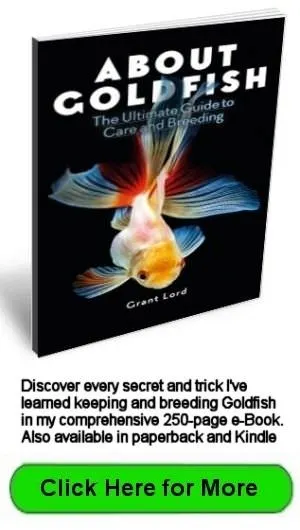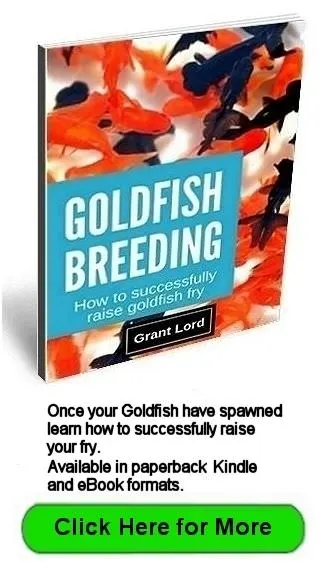- Home
- Aquariums
Goldfish Aquarium Guide
Aquariums suitable for Goldfish come in a variety of styles and materials.
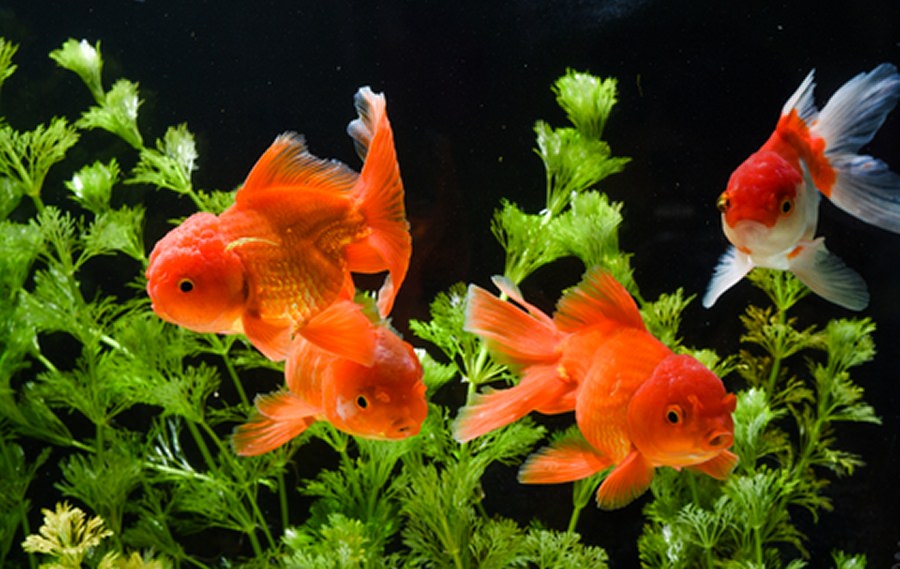
Last Updated 07-22-2023 by Grant Lord.
In the past Goldfish were considered to be small, short-lived aquarium fish that were very hardy and could be kept in small glass or plastic bowls.
Today, we know Goldfish are long-living, large-growing aquarium fish that thrive when given the right living environment.
Providing the right indoor environment requires a Goldfish tank that suits the number and variety of Goldfish you plan to keep and how much maintenance that will require.
Before we discuss tanks, let’s first discuss why bowls are not suitable for Goldfish
Are Bowls Suitable for Goldfish?
Goldfish bowls were used to keep Goldfish in for many years.
There were advantages to using a Goldfish bowl:
- They didn’t leak
- Smaller bowls could be picked up and easily moved
- They didn’t require substantial stands to sit on
- They were cheap
Disadvantages of bowls are:
- Limited ability to decorate
- Limited filtration options
- Small surface area
- Frequent water changes are required (because of limited filtration options)
- Viewing is distorted
- Goldfish quickly outgrow them (if water quality is properly maintained)
- The lifespans of Goldfish kept in bowls is the shortest (because water quality is hard to maintain).
It is possible to keep small Goldfish in a bowl (it is now banned in some more enlightened countries), but, because of the increased maintenance required and its harmful effects on the lifespan of Goldfish, bowls are now considered the worst environment to keep a Goldfish in.
What to Consider Before Buying a Goldfish Tank
Before rushing out and buying a tank that may be unsuitable, first, ask yourself the following questions:
What Goldfish variety or varieties do I plan to keep? Some Goldfish varieties grow large, 8-12 inches in body length, and these are also the cheapest and most commonly kept varieties.
What size aquarium do I need? This raises the following questions:
- What will the aquarium sit on, its own stand or a piece of furniture, and is the surface perfectly flat? Uneven surfaces are the most common reason aquarium bottom panes crack.
- Is the floor strong enough to support the weight of a large aquarium? A four foot (1.2m) aquarium with substrate will weigh approximately 330 Lbs (140kg)
- What size tank can I physically handle?
- If renting, am I allowed to have an aquarium, and is there a size limit?
How will I make water changes? Can the aquarium be siphoned and filled using a hose; using buckets is too time consuming for a large aquarium?
Will I be able to maintain the tank easily? Tall tanks can be hard to reach down to the bottom unless special equipment is used.
Where is the aquarium going to be placed? Aquariums should not be placed near windows or any source of direct or strong lighting, unless you plan to run a UV clarifier.
Is there a nearby power supply for the filter?
What Size Goldfish Tank Do I Need?
The simple answer is:
- A fully grown fancy Goldfish needs 20 gallons and 10 gallons for each additional fish.
- A fully grown single tailed variety needs 30 gallons and 15 gallons for each additional fish.
I go into more detail about tank size and how much room Goldfish need here, but rarely are fully grown Goldfish available for sale.
Most fish available at pet stores are juvenile fish a few months old and between 1-2 inches (25-50mm) in length.
Note:
Before we start discussing fish sizes and tank requirements, for clarity this website only uses body length when discussing fish sizes. The reason for this is that any other measurement can be misleading.
As an example, say a Comet has a length of 6” (150mm) including its tail which can be the same length as the body. This means the Comet’s body length is 3” (75mm).
If we now use the same 6” (150mm) measurement for a Common Goldfish, its body length will be over 4” (100mm). This difference in body length means the Common Goldfish will be double the body weight of the Comet.
There is nothing wrong with starting small, but you are now aware that your fish will grow, and at some point, you will either need a larger tank, or reduce fish numbers.
I would recommend as a minimum size a 15-20 gallon 2 foot tank, 15-18 inches high and 12 inches front to back with 2 small Goldfish. I would suggest against keeping any other fish species in with your Goldfish because some a tail nippers, and as your Goldfish grow, some smaller species such as White Cloud Mountain Minnows could become food. They also add to the bio-load that the filter has to deal with.
As the fish grow, you will need to make more frequent water changes to keep the water quality high. This will be indicated by your water test kit showing the nitrate level reaching 30 ppm (parts per million) more quickly.
This is the downside of having high numbers of fish per gallon; it means you need to do water changes much more frequently.
Aquarium Construction Materials
There are two types of materials used for aquarium manufacture these days, glass and acrylic.
Glass aquariums have the following advantages:
- Glass is cheap and readily available
- Construction is simple using RTV silicone glue, no frame is necessary
- Cleaning algae off the inside surface is easy
- Repairs to broken panes are simple.
Some disadvantages of glass aquariums are:
- The surface they sit on must be absolutely flat otherwise the bottom pane will crack
- Because they are so easy to make, care must be taken when buying second hand to ensure the glass thickness is correct for the aquarium size, and there are adequate braces fitted
- Limited design options, but you can get them with curved front panes
- Glass is fragile.
Acrylic aquariums have the following advantages:
- Design options are greater, for example tall tubular aquariums are possible
- Acrylic has greater clarity than glass
- Acrylic will take knocks without shattering
- They are lighter than glass aquariums of the same size.
Some disadvantages of acrylic aquariums are:
- They scratch easily
- Removing algae is harder and a special pad must be used
- The price is much higher than the glass equivalent
- Manufacturing and repairs can only be done by specialists.
Different Designs For Different Uses
Aquariums come in every size and shape. You need to choose the one that is going to be best suited for its intended use, such as:
- Breeding
- Growing up your Goldfish
- Displaying your Goldfish.
For each of these uses there is a Goldfish aquarium that suits the purpose best. For example:
- Breeding requires an aquarium that is not too tall, no more than 15”, and say 24” long by 12” front to back. This would be suitable for a breeding trio of small goldfish with body lengths of about 2 ½”. For a greater number of fish or larger fish, you will need an aquarium at least 3 feet long.
- Goldfish require a lot of space to grow properly. With no filtration or aeration, goldfish need 24 square inches of surface area per inch of fish to maintain an adequate oxygen level. This measurement however, doesn't determine what size aquarium you need. To work that out, go to the page that gives you all the facts about how much room Goldfish need.
- The best aquarium dimensions to display your Goldfish is a tall aquarium that is not too wide. 15” tall would be the minimum height, 18” tall would be better. I wouldn’t go any wider than 12” front to back unless you are putting very large fish in the aquarium. This width keeps the fish in view more often instead of them hiding at the back of the aquarium.
Goldfish Aquarium Purchasing Options
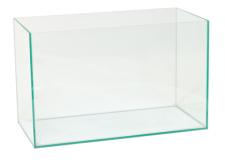 Plain glass aquarium
Plain glass aquariumWhen purchasing Goldfish aquariums, there are a few options available. You can:
- Purchase a bare glass or acrylic aquarium that will require a light, filter, and heater purchased separately, and find something to sit it on
- Purchase an aquarium that comes with some accessories such as a cover with an integral light and a small internal or under-gravel filter and air pump
- Purchase a complete package with a cover, light, integrated filter that sits under the cover, and a purpose-built stand.
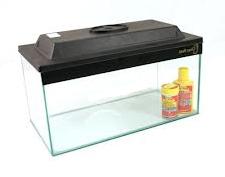 Aquarium with light
Aquarium with lightFew sellers of aquariums include gravel, plants or filter media (the filtering material you put inside the filter) with their packages.
For aquariums that will not be used for display purposes I would suggest purchasing bare aquariums. You can then purchase only the accessories you need.
Make sure the aquarium comes with a glass two piece cover. One piece of the cover should be no wider than 3” (75mm) so it can be raised separately for feeding and netting fish without having to take the whole cover off.
The cover stops evaporation, heat loss, fish jumping out and objects being dropped into the aquarium.
Goldfish Tank Equipment
If this is your first Goldfish tank, here is a check list of everything you need to set up and maintain the aquarium. Even if you purchase a complete aquarium package, make sure you are aware of what is not included.
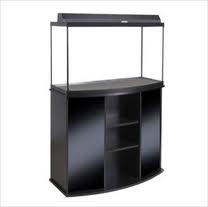 Goldfish aquarium on a stand with cover incorporating a light.
Goldfish aquarium on a stand with cover incorporating a light.- Filter and filter media
- Light unit including lamp
- Stand (optional)
- Aerator, airline and diffuser (optional)
- Siphon and filling hose(s)
- Algae scraper (acrylic tanks require a special cleaning pad)
- Water test kit that tests ammonia, nitrite and nitrate levels
- Aquarium thermometer
- Water conditioner/dechlorinator
- Substrate (gravel) (optional)
- Plants, live or imitation (optional)
- Decorations (optional)
- Fish net
- Heater (optional)
- Hospital tank or any suitably sized container (recommended)
Tip:
Complete aquarium packages can be quite expensive. Before buying new, check if any second hand items are available locally.
Be careful of cheaper aquarium packages as the imitation wood such as MDF used for the stands can be easily damaged if it gets wet, as it causes the material to swell.
Setting up Your Goldfish Tank
Once you have purchased your Goldfish tank and equipment, and possibly fish, you will want to set it up, add water, add the fish and start enjoying it.
Sometimes, with luck, there will be no problems and your fish will live long and healthy lives.
What usually happens is either the fish get sick or they die suddenly within 2-4 weeks.
There are three possible reasons for this:
- The fish were diseased when you purchased them
- The tank had an ammonia spike, often referred to as new tank syndrome or
- The fish were diseased and the tank had an ammonia spike.
Ammonia is toxic to all fish species, even in very small quantities of parts per million (ppm).
The Nitrogen Cycle
The primary function of the filter you installed is to remove ammonia, not keep the water clean.
An ammonia spike happens because the filter has not had enough time to go through the nitrogen cycle.
The nitrogen cycle is when the ammonia the fish produce from breathing and from their waste decomposing is processed by bacteria in the filter into nitrite. Nitrite is as toxic to fish as ammonia. Bacteria in the filter then convert the nitrite into nitrates, the much less harmful chemical.
You need a water test kit so you know at what stage your filter is in the nitrogen cycle, and when to make water changes when ammonia or nitrite is detected, and nitrates rise above 30 ppm.
My suggestion is don’t set up your aquarium with plants and substrate, but use it as a bare quarantine tank for 3-4 weeks while monitoring your water condition, and when nitrates are detected, you know your filter is cycled.
Go to the page with tips on Setting Up Goldfish Aquariums correctly, and then the page on Aquarium Cleaning that provides advice on making this chore as simple and painless as possible.
Top of Goldfish Aquariums page
